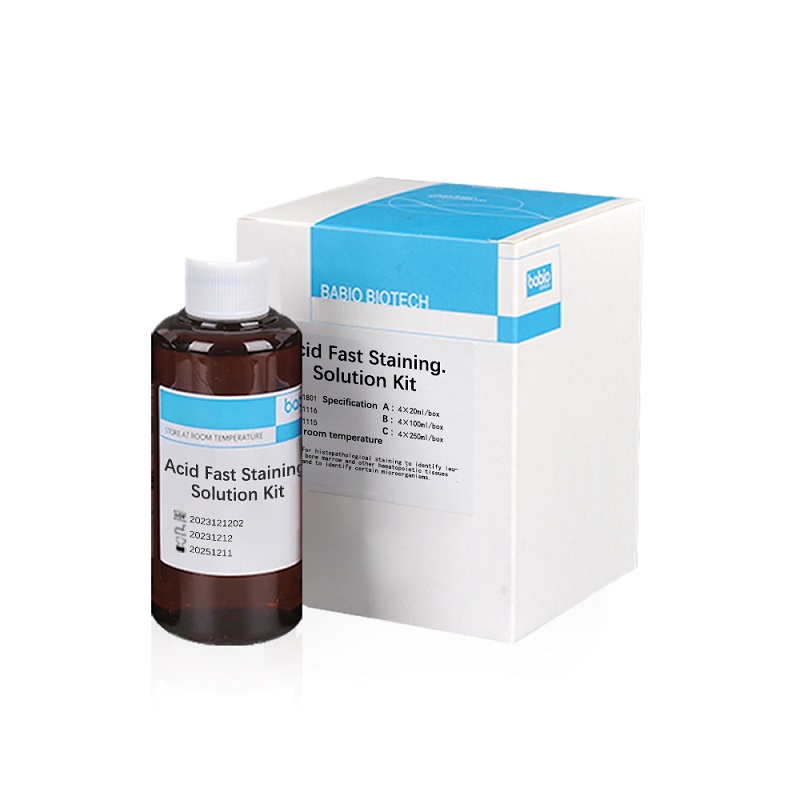
Product DescriptionBaibo Biotechnology Co., Ltd. is a renowned Chinese manufacturer of the Acid Fast Staining Solution Kit. As a leading producer, Baibo Biotechnology supports online wholesale and OEM customization, offering free samples to ensure customer satisfaction. Their Acid-fast stain kits are trusted for their quality and reliability in various laboratory settings.
【 Product name 】
Acid-fast dye solution
【 Packing specification 】
Type I: hot dyeing, cold dyeing
Instructions for acid-fast dye solution
Type I: fluorescence method
The packaging specifications of each single bottle (barrel) of dyeing liquid are :20m1, 100m1, 250m1, 500m1, 1L, 5L, and the packaging specifications of the whole group of dyeing liquid are :4x20ml/ box, 4X100ml/ box, 4x250m1/ box, 4x500m1/ box, 4X1L/ box, 4X5L/ box. Liquid 1 :4x250m1/ box, liquid 2 :4X250ml/ box, liquid 3 :4x250ml/ box.
【 Intended use 】
It is used for acid-fast staining of bacteria such as mycobacterium and Nocardia, including fluorescent staining
【 Test principle 】
Acid fast bacteria such as tuberculosis and leprosy bacilli are not easy to stain because of a layer of lipid or lipid skin film on the surface of their bacteria, but once colored, the effect of acid alcohol is not easy to decolorize it. Use this property and stain with enhanced dyeing solution, and then treat it with acidic alcohol to decolorize it and then contrast dyeing, at this time, the acid-resistant bacteria are still fixed the color of the initial pigment (red), which is easy to identify. After the mycobacterium is colored by auramine 0, it can resist the decolorization of acidic decolorization agents, so this type of bacteria is also called acid-fast bacteria, and acid-fast staining can be divided into two categories, namely acid-positive bacteria and acid-negative bacteria. Acid-positive bacteria can be detected faster than normal acid-positive bacteria because they are stained with fluorescent dye and then examined with fluorescent microscope containing ultraviolet light source
【 Main components 】
Type I: It is composed of carbolic acid compound red liquid (No. 1 liquid), acidic alcohol solution (No. 2 liquid), methylene blue solution (No. 3 liquid).
Type II: composed of gold amine 0 dye solution (No. 1 liquid), decolorization solution (No. 2 liquid), and multiple dye solution (No. 3 liquid).
【 Storage Conditions and expiry date 】
Store at room temperature in a dry and cool place; Valid for two years.
【 Interpretation of test results 】
Type I: Acid fast bacteria (Mycobacterium tuberculosis) in red, other bacteria and cells in blue.
Type II: Acid-fast bacilli (mainly Mycobacterium tuberculosis, non-tuberculous Mycobacterium and leprae) star bright yellow fluorescence.
【 Limitation of test method 】
Acid resistant bacteria only.
【 Note 】
1. This product should be used by professionals.
2. Please read the instruction manual carefully before use and use it within the validity period
3. After the reagent is used up, please cover it quickly to avoid volatilization.
4. When storing the kit, try to avoid high and low temperature environment and sunlight exposure.
5. When the room temperature is too low in winter, the dyeing time should be properly extended.
6, after the decolorization solution is used up, 5% hydrochloric acid alcohol solution can be made as a decolorization solution.
7. When acid-fast staining is used directly for sputum specimens, the thickness of the specimen smear can be appropriately increased to improve the detection rate. When dyeing thick smears, the re-dyeing time should be mastered. If the background is too dark, it will affect the microscopy.
8, sometimes on the same acid-fast bacteria, the shade of red is also different, which should be noted when observing.
9. For acid-fast staining of pathological tissue pieces, it is recommended to use heat dyeing method, but it should be noted that the dyeing time of liquid 1 should not be less than 5 minutes, so that a better dyeing effect can be obtained.
10, after use, waste should be disposed of according to the requirements of the hospital or environmental protection department.
11. The bacteria of Mycobacterium genus contain more lipids in the cell wall, so the conventional staining method is not easy to color, and the dyeing time can be extended or the dyeing temperature can be increased to make the bacteria colored.